Wenqi Shi
MENDR: Manifold Explainable Neural Data Representations
Aug 07, 2025Abstract:Foundation models for electroencephalography (EEG) signals have recently demonstrated success in learning generalized representations of EEGs, outperforming specialized models in various downstream tasks. However, many of these models lack transparency in their pretraining dynamics and offer limited insight into how well EEG information is preserved within their embeddings. For successful clinical integration, EEG foundation models must ensure transparency in pretraining, downstream fine-tuning, and the interpretability of learned representations. Current approaches primarily operate in the temporal domain, overlooking advancements in digital signal processing that enable the extraction of deterministic and traceable features, such as wavelet-based representations. We propose MENDR (Manifold Explainable Neural Data Representations), a filter bank-based EEG foundation model built on a novel Riemannian Manifold Transformer architecture to resolve these issues. MENDR learns symmetric positive definite matrix embeddings of EEG signals and is pretrained on a large corpus comprising over 4,000 hours of EEG data, decomposed via discrete wavelet packet transforms into multi-resolution coefficients. MENDR significantly enhances interpretability by visualizing symmetric positive definite embeddings as geometric ellipsoids and supports accurate reconstruction of EEG signals from learned embeddings. Evaluations across multiple clinical EEG tasks demonstrate that MENDR achieves near state-of-the-art performance with substantially fewer parameters, underscoring its potential for efficient, interpretable, and clinically applicable EEG analysis.
RAG in the Wild: On the (In)effectiveness of LLMs with Mixture-of-Knowledge Retrieval Augmentation
Jul 26, 2025Abstract:Retrieval-augmented generation (RAG) enhances large language models (LLMs) by integrating external knowledge retrieved at inference time. While RAG demonstrates strong performance on benchmarks largely derived from general-domain corpora like Wikipedia, its effectiveness under realistic, diverse retrieval scenarios remains underexplored. We evaluated RAG systems using MassiveDS, a large-scale datastore with mixture of knowledge, and identified critical limitations: retrieval mainly benefits smaller models, rerankers add minimal value, and no single retrieval source consistently excels. Moreover, current LLMs struggle to route queries across heterogeneous knowledge sources. These findings highlight the need for adaptive retrieval strategies before deploying RAG in real-world settings. Our code and data can be found at https://github.com/ritaranx/RAG_in_the_Wild.
AsyncFlow: An Asynchronous Streaming RL Framework for Efficient LLM Post-Training
Jul 02, 2025Abstract:Reinforcement learning (RL) has become a pivotal technology in the post-training phase of large language models (LLMs). Traditional task-colocated RL frameworks suffer from significant scalability bottlenecks, while task-separated RL frameworks face challenges in complex dataflows and the corresponding resource idling and workload imbalance. Moreover, most existing frameworks are tightly coupled with LLM training or inference engines, making it difficult to support custom-designed engines. To address these challenges, we propose AsyncFlow, an asynchronous streaming RL framework for efficient post-training. Specifically, we introduce a distributed data storage and transfer module that provides a unified data management and fine-grained scheduling capability in a fully streamed manner. This architecture inherently facilitates automated pipeline overlapping among RL tasks and dynamic load balancing. Moreover, we propose a producer-consumer-based asynchronous workflow engineered to minimize computational idleness by strategically deferring parameter update process within staleness thresholds. Finally, the core capability of AsynFlow is architecturally decoupled from underlying training and inference engines and encapsulated by service-oriented user interfaces, offering a modular and customizable user experience. Extensive experiments demonstrate an average of 1.59 throughput improvement compared with state-of-the-art baseline. The presented architecture in this work provides actionable insights for next-generation RL training system designs.
MedAgentGym: Training LLM Agents for Code-Based Medical Reasoning at Scale
Jun 04, 2025Abstract:We introduce MedAgentGYM, the first publicly available training environment designed to enhance coding-based medical reasoning capabilities in large language model (LLM) agents. MedAgentGYM comprises 72,413 task instances across 129 categories derived from authentic real-world biomedical scenarios. Tasks are encapsulated within executable coding environments, each featuring detailed task descriptions, interactive feedback mechanisms, verifiable ground-truth annotations, and scalable training trajectory generation. Extensive benchmarking of over 30 LLMs reveals a notable performance disparity between commercial API-based models and open-source counterparts. Leveraging MedAgentGYM, Med-Copilot-7B achieves substantial performance gains through supervised fine-tuning (+36.44%) and continued reinforcement learning (+42.47%), emerging as an affordable and privacy-preserving alternative competitive with gpt-4o. By offering both a comprehensive benchmark and accessible, expandable training resources within unified execution environments, MedAgentGYM delivers an integrated platform to develop LLM-based coding assistants for advanced biomedical research and practice.
WorkForceAgent-R1: Incentivizing Reasoning Capability in LLM-based Web Agents via Reinforcement Learning
May 28, 2025Abstract:Large language models (LLMs)-empowered web agents enables automating complex, real-time web navigation tasks in enterprise environments. However, existing web agents relying on supervised fine-tuning (SFT) often struggle with generalization and robustness due to insufficient reasoning capabilities when handling the inherently dynamic nature of web interactions. In this study, we introduce WorkForceAgent-R1, an LLM-based web agent trained using a rule-based R1-style reinforcement learning framework designed explicitly to enhance single-step reasoning and planning for business-oriented web navigation tasks. We employ a structured reward function that evaluates both adherence to output formats and correctness of actions, enabling WorkForceAgent-R1 to implicitly learn robust intermediate reasoning without explicit annotations or extensive expert demonstrations. Extensive experiments on the WorkArena benchmark demonstrate that WorkForceAgent-R1 substantially outperforms SFT baselines by 10.26-16.59%, achieving competitive performance relative to proprietary LLM-based agents (gpt-4o) in workplace-oriented web navigation tasks.
Novel Extraction of Discriminative Fine-Grained Feature to Improve Retinal Vessel Segmentation
May 06, 2025Abstract:Retinal vessel segmentation is a vital early detection method for several severe ocular diseases. Despite significant progress in retinal vessel segmentation with the advancement of Neural Networks, there are still challenges to overcome. Specifically, retinal vessel segmentation aims to predict the class label for every pixel within a fundus image, with a primary focus on intra-image discrimination, making it vital for models to extract more discriminative features. Nevertheless, existing methods primarily focus on minimizing the difference between the output from the decoder and the label, but ignore fully using feature-level fine-grained representations from the encoder. To address these issues, we propose a novel Attention U-shaped Kolmogorov-Arnold Network named AttUKAN along with a novel Label-guided Pixel-wise Contrastive Loss for retinal vessel segmentation. Specifically, we implement Attention Gates into Kolmogorov-Arnold Networks to enhance model sensitivity by suppressing irrelevant feature activations and model interpretability by non-linear modeling of KAN blocks. Additionally, we also design a novel Label-guided Pixel-wise Contrastive Loss to supervise our proposed AttUKAN to extract more discriminative features by distinguishing between foreground vessel-pixel pairs and background pairs. Experiments are conducted across four public datasets including DRIVE, STARE, CHASE_DB1, HRF and our private dataset. AttUKAN achieves F1 scores of 82.50%, 81.14%, 81.34%, 80.21% and 80.09%, along with MIoU scores of 70.24%, 68.64%, 68.59%, 67.21% and 66.94% in the above datasets, which are the highest compared to 11 networks for retinal vessel segmentation. Quantitative and qualitative results show that our AttUKAN achieves state-of-the-art performance and outperforms existing retinal vessel segmentation methods. Our code will be available at https://github.com/stevezs315/AttUKAN.
Collab-RAG: Boosting Retrieval-Augmented Generation for Complex Question Answering via White-Box and Black-Box LLM Collaboration
Apr 07, 2025Abstract:Retrieval-Augmented Generation (RAG) systems often struggle to handle multi-hop question-answering tasks accurately due to irrelevant context retrieval and limited complex reasoning capabilities. We introduce Collab-RAG, a collaborative training framework that leverages mutual enhancement between a white-box small language model (SLM) and a blackbox large language model (LLM) for RAG. Specifically, the SLM decomposes complex queries into simpler sub-questions, thus enhancing the accuracy of the retrieval and facilitating more effective reasoning by the black-box LLM. Concurrently, the black-box LLM provides feedback signals to improve the SLM's decomposition capability. We observe that Collab-RAG relies solely on supervision from an affordable black-box LLM without additional distillation from frontier LLMs, yet demonstrates strong generalization across multiple black-box LLMs. Experimental evaluations across five multi-hop QA datasets demonstrate that Collab-RAG substantially outperforms existing black-box-only and SLM fine-tuning baselines by 1.8%-14.2% on average. In particular, our fine-tuned 3B SLM surpasses a frozen 32B LLM in question decomposition, highlighting the efficiency of Collab-RAG in improving reasoning and retrieval for complex questions. The code of Collab-RAG is available on https://github.com/ritaranx/Collab-RAG/.
Advancing Problem-Based Learning in Biomedical Engineering in the Era of Generative AI
Mar 20, 2025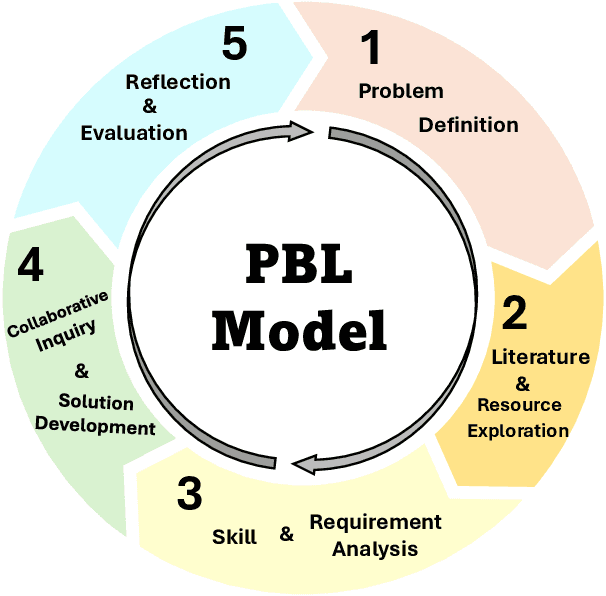
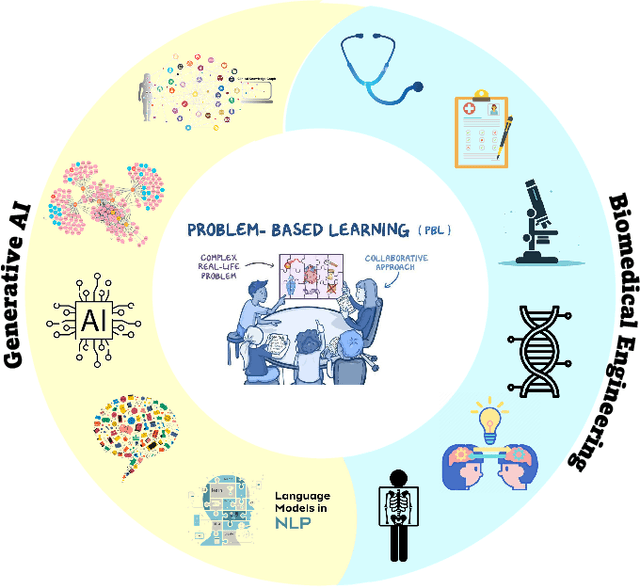

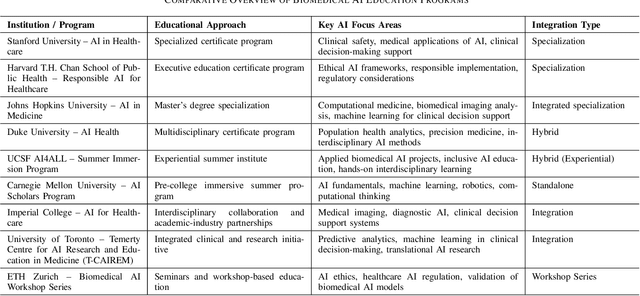
Abstract:Problem-Based Learning (PBL) has significantly impacted biomedical engineering (BME) education since its introduction in the early 2000s, effectively enhancing critical thinking and real-world knowledge application among students. With biomedical engineering rapidly converging with artificial intelligence (AI), integrating effective AI education into established curricula has become challenging yet increasingly necessary. Recent advancements, including AI's recognition by the 2024 Nobel Prize, have highlighted the importance of training students comprehensively in biomedical AI. However, effective biomedical AI education faces substantial obstacles, such as diverse student backgrounds, limited personalized mentoring, constrained computational resources, and difficulties in safely scaling hands-on practical experiments due to privacy and ethical concerns associated with biomedical data. To overcome these issues, we conducted a three-year (2021-2023) case study implementing an advanced PBL framework tailored specifically for biomedical AI education, involving 92 undergraduate and 156 graduate students from the joint Biomedical Engineering program of Georgia Institute of Technology and Emory University. Our approach emphasizes collaborative, interdisciplinary problem-solving through authentic biomedical AI challenges. The implementation led to measurable improvements in learning outcomes, evidenced by high research productivity (16 student-authored publications), consistently positive peer evaluations, and successful development of innovative computational methods addressing real biomedical challenges. Additionally, we examined the role of generative AI both as a teaching subject and an educational support tool within the PBL framework. Our study presents a practical and scalable roadmap for biomedical engineering departments aiming to integrate robust AI education into their curricula.
MedAgentsBench: Benchmarking Thinking Models and Agent Frameworks for Complex Medical Reasoning
Mar 10, 2025Abstract:Large Language Models (LLMs) have shown impressive performance on existing medical question-answering benchmarks. This high performance makes it increasingly difficult to meaningfully evaluate and differentiate advanced methods. We present MedAgentsBench, a benchmark that focuses on challenging medical questions requiring multi-step clinical reasoning, diagnosis formulation, and treatment planning-scenarios where current models still struggle despite their strong performance on standard tests. Drawing from seven established medical datasets, our benchmark addresses three key limitations in existing evaluations: (1) the prevalence of straightforward questions where even base models achieve high performance, (2) inconsistent sampling and evaluation protocols across studies, and (3) lack of systematic analysis of the interplay between performance, cost, and inference time. Through experiments with various base models and reasoning methods, we demonstrate that the latest thinking models, DeepSeek R1 and OpenAI o3, exhibit exceptional performance in complex medical reasoning tasks. Additionally, advanced search-based agent methods offer promising performance-to-cost ratios compared to traditional approaches. Our analysis reveals substantial performance gaps between model families on complex questions and identifies optimal model selections for different computational constraints. Our benchmark and evaluation framework are publicly available at https://github.com/gersteinlab/medagents-benchmark.
MedAdapter: Efficient Test-Time Adaptation of Large Language Models towards Medical Reasoning
May 05, 2024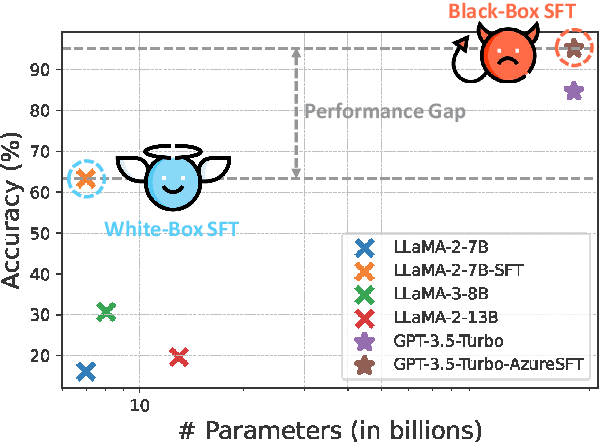
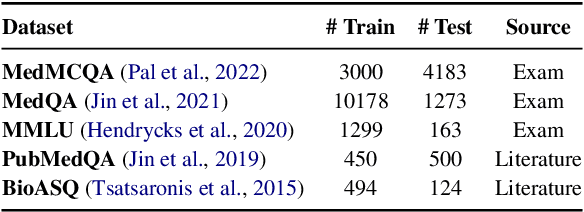

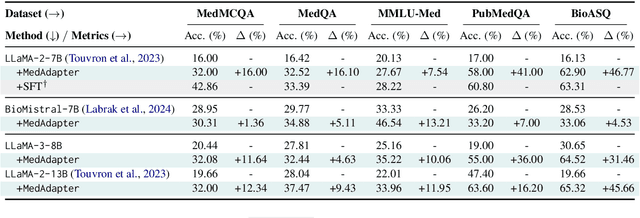
Abstract:Despite their improved capabilities in generation and reasoning, adapting large language models (LLMs) to the biomedical domain remains challenging due to their immense size and corporate privacy. In this work, we propose MedAdapter, a unified post-hoc adapter for test-time adaptation of LLMs towards biomedical applications. Instead of fine-tuning the entire LLM, MedAdapter effectively adapts the original model by fine-tuning only a small BERT-sized adapter to rank candidate solutions generated by LLMs. Experiments demonstrate that MedAdapter effectively adapts both white-box and black-box LLMs in biomedical reasoning, achieving average performance improvements of 25.48% and 11.31%, respectively, without requiring extensive computational resources or sharing data with third parties. MedAdapter also yields superior performance when combined with train-time adaptation, highlighting a flexible and complementary solution to existing adaptation methods. Faced with the challenges of balancing model performance, computational resources, and data privacy, MedAdapter provides an efficient, privacy-preserving, cost-effective, and transparent solution for adapting LLMs to the biomedical domain.
 Add to Chrome
Add to Chrome Add to Firefox
Add to Firefox Add to Edge
Add to Edge